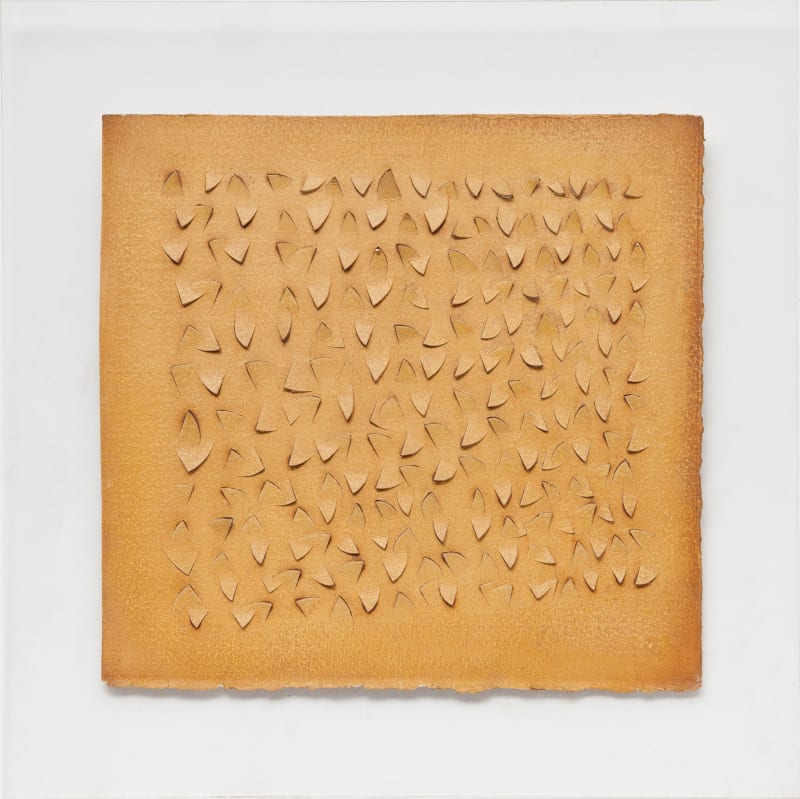Arthur Luiz Piza (São Paulo, SP, 1928 - Paris, France, 2017). Printmaker, draughtsman, sculptor. He began his artistic training in 1943, studying painting and fresco with Antonio Gomide (1895-1967). After participating in the 1ª Bienal Internacional de São Paulo in 1951, he traveled to Europe and lived in Paris. He attended the studio of Johnny Friedlaender (1912-1992) and perfected the techniques of metal engraving, etching, intaglio, water-ink and drypoint. In 1953, he participated in the 2ª Bienal Internacional de São Paulo and won the acquisition prize. At its 5th edition, in 1959, he was awarded the national prize for printmaking. During this period, he began to work on reliefs, perforating his watercolors and using their fragments in collages on canvas, paper, copper and wood. He later created metal reliefs on sisal fiber, and produced large-scale three-dimensional pieces, as well as works in porcelain and jewelry. He created illustrations for several books, in small print runs. In the late 1980s, he created a three-dimensional mural for the French Cultural Center in Damascus, Syria. In 2002, the largest exhibition of his relief pieces was held, curated by Paulo Sergio Duarte (1946), at the Pinacoteca do Estado de São Paulo (_Pina) and at the Museu de Arte do Rio Grande do Sul Ado Malagoli (Margs).
Analysis
In 1951, he studied in Paris with Johnny Friedlaender (1912-1992) and perfected metal engraving techniques. His first etchings dialogue with Friedlaender's irregular graphics and surrealist nuances.
Gradually his works gained a greater constructive concern, with the geometrization of the elements. Piza introduced a new way of working in engraving: he began to sculpt geometric shapes, rounded, rectangular, or triangular, with the use of burin, gouges, a nail, and a hammer. These prints explored the transition between areas of different depths and the interaction created with light.
Piza then realized that it was possible to translate this procedure into painting. In 1959 he began to make reliefs by perforating watercolors and using their fragments to make collages on paper or canvas, like mosaics, which were sometimes covered with layers of paint. According to the artist, the material was organized based on the search for each composition's own rhythm, independently from others that were already finished.
As scholar Stella Teixeira de Barros points out, in his production the color insinuates itself more and more, as does the rhythm of the particles. The forms tend to cluster in more saturated plots. For critic Paulo Sérgio Duarte, these reliefs present a desire for order that does not materialize. Although they contain something that refers to serialization and repetition, the tiny particles, subtly irregular, combine and coexist with a freedom of direction eventually close to chaotic.
In the series Capachos, 1979, the artist's tendency to occupy space becomes more visible. The works are composed of triangles attached in metal pins on pieces of sisal fiber. As critic Tiago Mesquita points out, in these works what previously suggested volume and flow is transformed into three-dimensionality. In 1986, Piza developed a mural for the French Cultural Center, in Damascus, with a poetics close to that presented in the works from these series.
The series Corte e Recorte, 1984/1985 was executed with deep incisions on sheets of paper. In some of these works, color amplifies the perception of volumes. In others, as Barros points out, the preservation of white paper makes the work reach the peak of modulated and changing luminosity. It is also possible to perceive the marks of the artist's gesture, in a process similar to engraving.
Piza also developed experiments with wood carving, projected utensils such as plates, vases, and porcelain objects, and created chiseled metal objects and jewelry.
Source: PIZA . In: ENCICLOPÉDIA Itaú Cultural de Arte e Cultura Brasileiras. São Paulo: Itaú Cultural, 2021. Available at: <http://enciclopedia.itaucultural.org.br/pessoa9617/piza>. Accessed on: June 9, 2021. Encyclopedia entry. ISBN: 978-85-7979-060-7

